If you’ve followed this website for a while, you likely noticed my obsession with an unreleased game called Bounty Arms. Data West announced it for the first round of PlayStation games in 1995, and it brought a novel idea. The game’s two anime heroines wander overhead-view stages, much like the protagonists of Mercs or Outzone or dozens of similar shooters. Instead of standard-issue firearms, however, they wield telescoping Relic Arms that serve as whips, grappling hooks, and all-destroying flamethrowers.
Bounty Arms: The Demo in Full
Alas, this promising title vanished from sight around the middle of 1995, with Data West moving on to another game and subsequently retreating from the industry. A scrap of Bounty Arms made its way to the public, though.
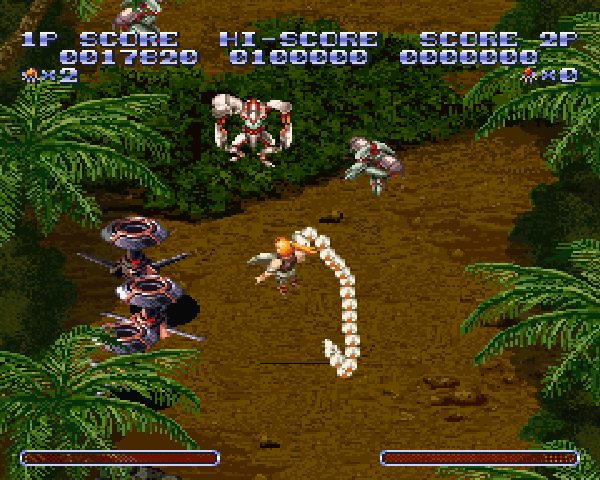
Demo Demo PlayStation, a Japan-only line of discs meant primarily for kiosks, includes a Bounty Arms preview video on its fourth volume and a playable half-stage on its fifth. The demo’s very limited: protagonists Rei Misazaki and Chris Prenaculutaoraroato (which is how I’ll translate her last name for the time being) don’t take damage at all, and the game reboots once they destroy the mid-stage boss. Yet the graphics for the entire first stage appear to be in the demo, and I always hoped that someone would figure out how to play the entire level.
Well, someone did! Tumblr user Human of Mi-Com Age ran the demo alongside Cheat Engine and tricked the game into letting you play the whole first stage, including a clash with the electricity-spewing robotic serpent boss. I’ll let Human’s brilliant post detail the actual method. It’s a relatively easy hack once you figure out Cheat Engine, and I pulled it off despite having no programming knowledge beyond remembering some passwords for the NES version of Strider.
To sum it up, the mid-boss won’t appear when its value is disabled, and this allows Chris and Rei to march beyond the usual cutoff point. From there, the rest of the first level of Bounty Arms is yours to explore.
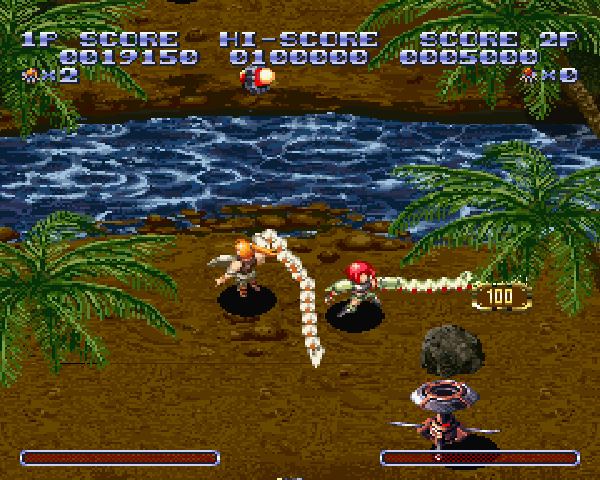
There are no grand secrets beyond, I admit. The game just throws denser waves of the same enemies Chris and Rei faced in the level’s first leg, and since our heroines are invincible we’re left to imagine how difficult it all might be in finished form. Even so, some new and interesting sights await.
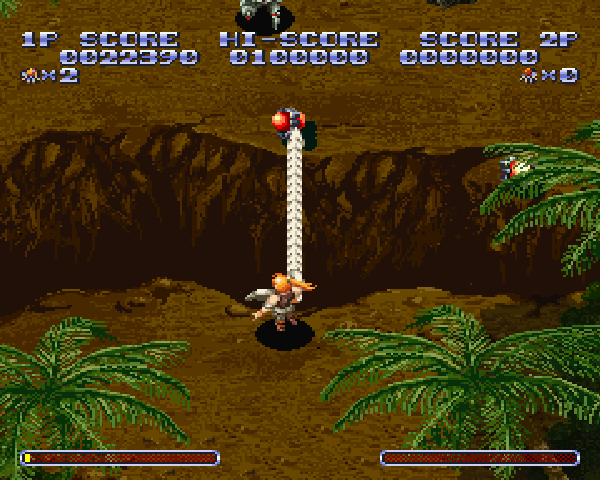
More notable are the grappling points, little glowing nodules that the Relic Arm latches onto so that Chris and Rei can cross ravines and rivers. Oddly, the demo has barriers set up to prevent river fording, so you’ll have to disable collision detection, too.
The highlight of the stage, of course, is the massive mecha-snake that bursts out of a waterfall cave, provided you re-enable the boss and collision values in Cheat Engine. It can’t damage Chris and Rei any more than other attackers can, but it’s fascinating to watch—especially when the tiny man in the machine’s cockpit summons huge bolts of lightning. It might’ve posed a real challenge in the actual game, too. Chris and Rei were apparently meant to perish after one hit, and the serpent is quick and nasty.
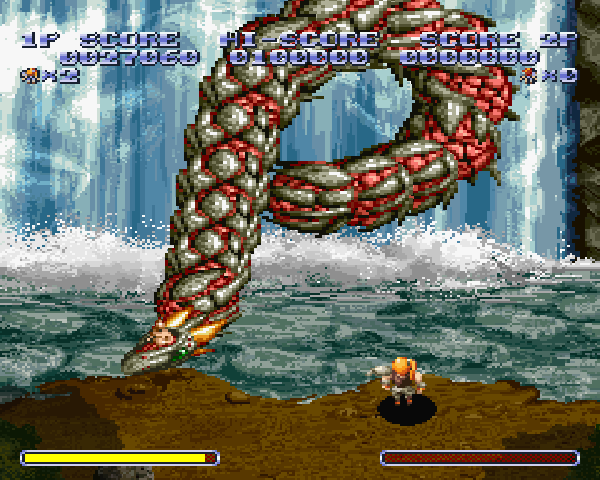
The demo shuts down once the robo-snake explodes, having shown all available graphics. Of course, you’re welcome to leave the boss and collision values off. This lets Chris and Rei proceed through the waterfall and roam an arid, vacant realm where the background repeats endlessly and only the “GO!” sign extorts them onward in a pointless cycle, like Waiting for Godot meets Bionic Commando.
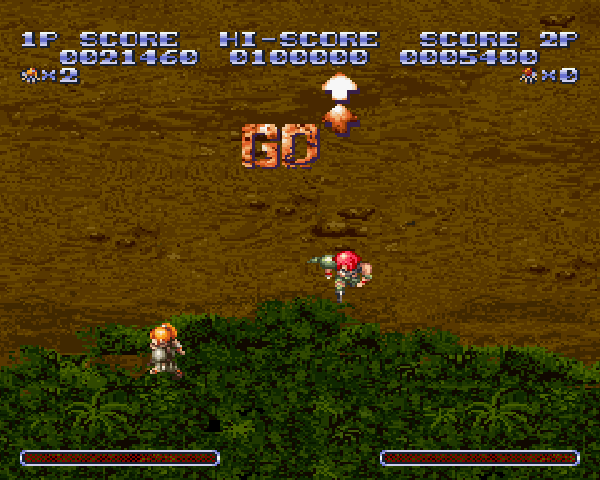
And so the entire first stage of Bounty Arms is playable for anyone who cares to try it. Going through it reminded me of why I was so curious when I first spied Bounty Arms in an old issue of GameFan. At first sight, it evokes the best years of the vertical-scrolling shooter. Yet it also evolves, replacing the typical gunplay with a cybernetic arm that grapples, reflects, and attacks. And all with one button, no less.
Once again I wonder why Bounty Arms was canceled. Some revelations appeared with John Szczepaniak’s first volume of The Untold History of Japanese Game Developers. An interview there sees composer Yasuhito Saito discussing his work at several companies, and Data West is among them. Saito can’t say why Bounty Arms vanished, but he drops plenty of intriguing details: the game was 60 percent complete, Data West planned to make between 30,000 and 40,000 copies, and it was abruptly dropped even as Saito met with magazines and Sony representatives to promote the game. Sony also called him several times to ask why it wasn’t coming out. Perhaps Sony was eager for just about any game in the PlayStation’s shaky first quarter, but I like to think that someone there saw potential in Bounty Arms.
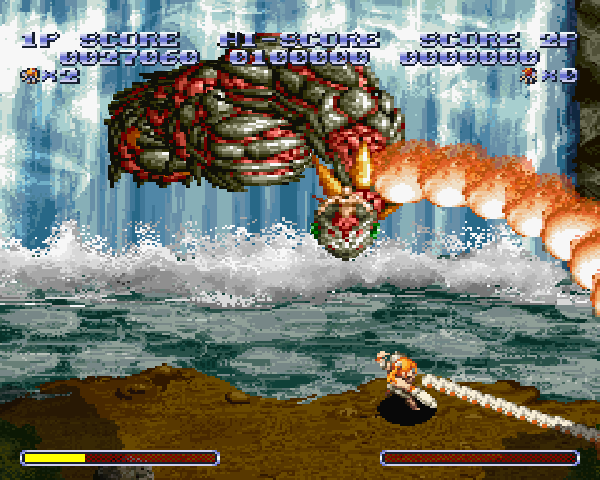
Another clue might lie in the credits for other Data West titles. Most of their action games are the work of Team 50, likely an internal club at the company. Kazuhide Nakamura figures prominently there. He directed the three Rayxanber shooters on the FM Towns and PC Engine, plus the first Vajra, a full-motion-video shooter for the Laseractive. He likely also helmed the second Vajra, which Data West released right before announcing Bounty Arms. Granted, Vajra 2 lists “Kenji Nakamura” as the director instead of Kazuhide, but…eh, that’s not an unrealistic stretch.
But what if you check the credits for Brave Prove, the only game Data West released after canceling Bounty Arms? Nakamura is nowhere to be seen. Brave Prove’s director is Noboru Nishizawa, a Data West staffer who worked on Vajra 2. From there a theory emerges: Either Data West canceled Bounty Arms because Nakamura left, or Nakamura left because Data West canceled Bounty Arms.
Perhaps Data West got cold feet. Bounty Arms may have an innovative weapon, but its first stage is an arcade creature, relying on pattern memorization and straightforward action. In an age when other companies embraced complex 3-D games and long RPGs for the home market, a traditional outing like Bounty Arms seemed anachronistic. The question of balancing the game also arises. As it seems in the demo, Chris and Rei can overcome any foes by charging up the Relic Arm right before they move forward. Was Bounty Arms just too basic?
Whatever it was, I want to know everything about Bounty Arms. And thanks to Human of Micom-Age, I know a little bit more.
Subscribe to:
Post Comments (Atom)

No comments:
Post a Comment